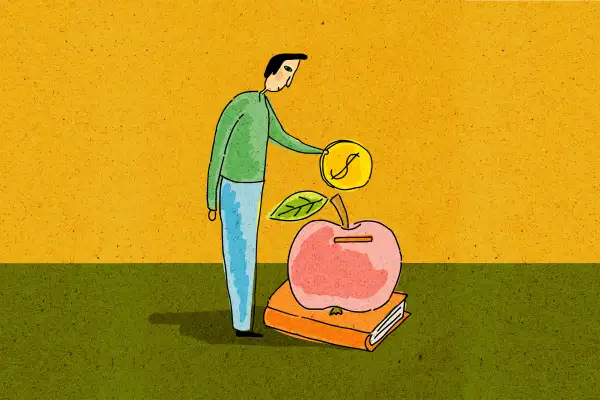Here's the Latest on Student Loans, Refinance Rates and More for June 15, 2020

Four out of 10 college students say they expect they’ll need to borrow more this fall to pay tuition bills. That’s the latest in a series of surveys that highlight the pressure the coronavirus is putting on students’ plans to pay for college.
Even before the pandemic and resulting recession, paying for college was no easy feat: Tuition at public four-year colleges now averages more than $10,000 a year for in-state students, and that doesn’t include housing, books, and other living expenses. Nearly two-thirds of bachelor’s degree recipients have to use loans to help cover the total bill.
This year, some students will be forced to rely on student loans more heavily to afford to go to college. Others may opt to attend a less expensive school or sit out a year to try to avoid debt.
Money’s roundup of the latest student loan news and interest rates can guide you through your decision.
College News and Student Loan Updates For 2020
A new survey of financial aid administrators finds most are anticipating a surge in requests for more financial aid, as college students and their parents deal with the economic fallout of the coronavirus.
Nine out of 10 colleges told the National Association of Student Financial Aid Administrators they anticipate an increase in the number of families asking the college to reevaluate their finances.
If you’ve lost your job or had your wages cut in the time since you filed your financial aid forms, you can ask for what’s called a special circumstances appeal from your college. A financial aid administrator will then review your details and determine whether you can qualify for additional money, like a Pell grant from the federal government or a scholarship from the college. In fact, nearly half of colleges told NASFAA said they’ve already seen an increase in such requests between March and the end of May, compared with last year’s numbers.
But there’s no guarantee asking for a reevaluation will result in more money, especially when colleges are dealing with an influx in requests. Check out Money’s six-step process for requesting more aid.
Current Federal Rates and What to Know
If you need to borrow for college, federal student loans should be the first option you explore, as they are easy to access. They don’t require credit checks and nearly any student in good academic standing can get them. Federal loans also offer more flexible repayment options than private loans. Annual borrowing limits range between $5,500 to $12,500, depending on your school year and dependency status.
Interest rates for federal student loans are set every year using the results from the 10-year Treasury note auction each May. Those rates affect all federal student loans disbursed between July 1and June 30 of the upcoming year.
As a result of the economic fallout caused by the coronavirus pandemic, interest rates have fallen to record lows, which means that federal student loans for the upcoming 2020-2021 academic year will have the lowest rates in over a decade.
Here’s a breakdown of both the current and upcoming interest rates:
Federal Student Loan Rates: 2019-2020
- Undergraduate Direct Subsidized and Unsubsidized loans - 4.53%
- Graduate or Professional Unsubsidized loans - 6.08%
- Direct PLUS loans - 7.08%
Federal Student Loan Rates: 2020-2021
- Undergraduate Direct Subsidized and Unsubsidized loans - 2.75%
- Graduate or Professional Unsubsidized loans - 4.30%
- Direct PLUS loans - 5.30%
Compared to last year, students will be paying 1.78% less on interest, which could save you hundreds to thousands of dollars over the life of the loan. For example, if you took an undergraduate loan last year for $7,500 with a 4.53% interest rate, and a standard 10-year repayment plan, you will be paying around $1,840 worth of interest. If you take out that same loan this year, with the same repayment plan, but with the 2.75% interest rate, you’ll only be paying $1,087 worth of interest.
Private Student Loan Rates
Private student loans are an option to bridge the financial gap when you’ve exhausted all other types of financial aid avenues, including federal loans.
Martin Lynch, compliance manager and director of education at Cambridge Credit Counseling Corp., says students should only use private loans as a last resort, and they should be as conservative as you possibly can with the amount you wish to borrow, and he suggests to only use them as a last resort.
“Always max out the federal loans first,” Lynch, who also serves the Financial Counseling Association of America’s board of directors, says.
Unlike federal loans, which only have fixed interest rates, private student loans offer both fixed and variable interest rates.The specific rate you get will depend on your (or your parents’) creditworthiness. With a fixed rate, payments stay the same over the life of the loan, while with a variable rate your payments may fluctuate based on current market conditions.
Most private student loans currently use the 3-month London Interbank Offered Rate, commonly known as “LIBOR,” as their baseline to set their interest rate ranges. The LIBOR usually follows the federal funds rate closely.
Last week, the Federal Reserve announced that the federal funds target rate will remain close to zero possibly until 2022. In other words, it’s unlikely private loan rates will increase in the near future.
Here are today’s private student loan rates for undergraduate students from some of the nation’s largest lenders:
Wells Fargo
- Fixed: 4.78% - 10.97%
- Variable: 2.93% - 9.70%
SoFi
- Fixed: 4.73% - 11.46%
- Variable: 1.30% - 10%
Sallie Mae
- Fixed: 4.74%- 11.85%
- Variable: 1.25% - 9.44%
Discover
- Fixed: 4.49% - 12.39%
- Variable: 1.49% - 11.49%
College Ave
- Fixed: 4.64% - 13.24%
- Variable: 1.74% - 12.23%
Refinancing Student Loans
If you already have private student loans, there’s probably never been a better time to refinance. With benchmark interest rates so low, your chances of securing a better interest rate are extremely high, especially if you have a good credit score of 720 or over, and a steady source of income.
Refinancing your private student loans can help you save money by lowering your interest rate. In some cases, you can also lower your monthly payment. If you have more than one loan, this can also be an option to help you consolidate multiple payments into a single one, plus it can help you release a cosigner.
When it comes to federal student loans, refinancing may not be the best option. “You would lose some of the benefits, like access to forgiveness programs,” says Brenda Hicks, director of financial aid at Southwestern College in Winfield, Kansas.
“It's really tough to beat the federal student loan rate, even if it's an unsubsidized loan. Federal student loans are at 2.75% right now, and that's incredible. I don't think you're going to be able to get a better rate than that, unless you have an incredibly good credit or a cosigner that's amazing,” she adds. However, Hicks says that for private or parent loans, refinancing could be a good move because rates in the private sector are at all-time lows.
Let’s say you currently owe $10,000 on a private student loan with a 9% interest rate and 5 years remaining on the repayment term. With that loan, you’ll end up paying the balance of $10,000, in addition to $2,455 worth of interest.
If you refinance that $10,000 with the same 5-year term, but with a 4% interest rate, you’ll end up paying less each month and only $1,050 worth of interest. In this case, refinancing saved you $1,400.
Here are today’s refinancing rates from some of the nation’s best-known refinance companies:
CommonBond
- Fixed: 3.2% - 6.43%
- Variable: 3.2% - 6.08%
Earnest
- Fixed: 3.45% - 6.68%
- Variable: 2.64% - 6.68%
More from Money:
Why Private Student Loan Borrowers Should Refinance Right Now
With Interest Rates Near All-Time Lows, Here’s What to Know About Refinancing Your Student Loans
A Mistake Caused Credit Scores to Drop for Tons of Student Loan Borrowers. Here's How to Fix Yours

